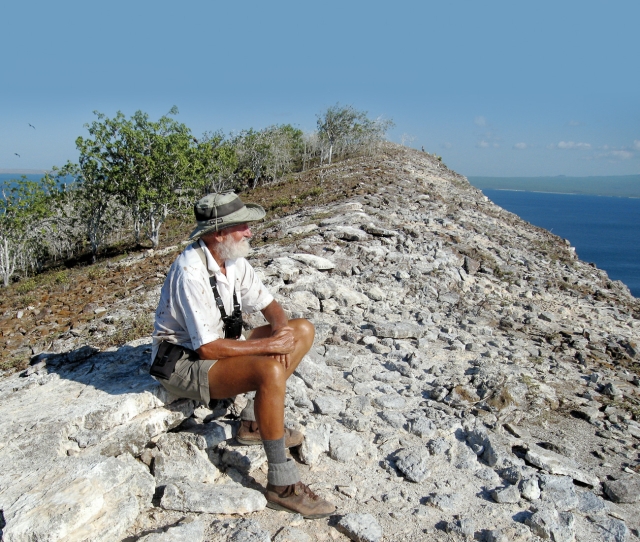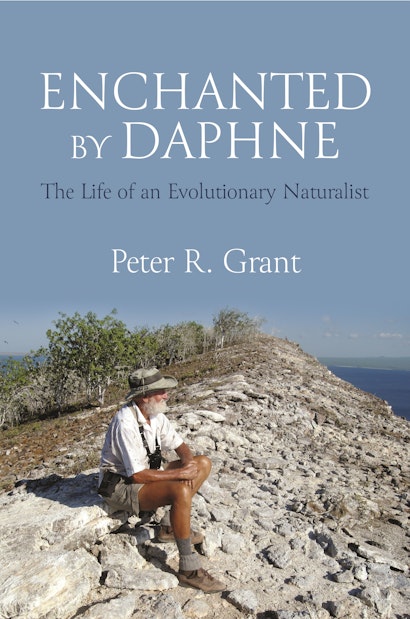Enchanted by Daphne is legendary ecologist Peter Grant’s personal account of his remarkable life and career. In this revelatory book, Grant takes readers from his childhood in World War II–era Britain to his ongoing research today in the Galápagos archipelago, vividly describing what it’s like to do fieldwork in one of the most magnificent yet inhospitable places on Earth. This is also the story of two brilliant and courageous biologists raising a family together while balancing the demands of professional lives that would take them to the far corners of the globe.
Your autobiography tells the story of a biologist who grew up in England, trained in Canada, and taught at Princeton University for many years before retiring. And you worked in South America! Could you briefly describe your background and how it oriented your future life?
PG: I think of my life as a journey. The journey started in suburban London before the beginning of World War II, and like many children in cities, I was evacuated to a school in the countryside. My journey continued after the war to a school in Croydon and from there to the University of Cambridge as an undergraduate. Two significant travels influenced the subsequent journey. The first was a visit to Paris with my father and my cousin Brian when I was 14 years old. The second was to North America in the summer before my last undergraduate year. I earned some money parking cars in Vancouver and then hitchhiked around the coastal United States. I was thrilled by the experience of traveling in new countries, and those experiences emboldened me to look for a place to do graduate work in North America. I found that place at the University of British Columbia. I like to think that I chose my path to becoming a professional biologist, and then the path chose where to take me: first to McGill University, then to the University of Michigan, and finally to Princeton, my home for 37 years.
The subtitle of your book is The Life of an Evolutionary Naturalist. Have you always been a naturalist? Was there an experience early in your life that was influential?
PG: I have always been fascinated by the natural world, but I have no idea what switched me on to nature in the first place. I do know that my cousin Brian and I explored nature in a park in suburban London when I was three and he was four. However, I believe my interest in animals and plants began earlier, because an even earlier memory was smelling marigolds. One thing I can be certain about: neither my father or mother played any role, for both of them had no interest in gardens or the natural world!
Your autobiography describes how you and your wife Rosemary returned to Galápagos year after year, mainly to the single small island of Daphne Major. How did you choose to work on Galápagos? And why did you pick Daphne?
PG: For many years, I was studying competition between species for food. At McGill University, I set up an experiment with mice and voles in large outdoor enclosures. The experiments demonstrated that woodland and grassland species would enter each other’s habitats in their absence but not in their presence, as expected if they were in competition for space. I then decided to switch my research to competition for food. I recalled reading David Lack’s 1947 book on Darwin’s finches while I was at Cambridge. He made the argument about competition for food, similar to mine about competition for space. For example, on islands where the small and the medium ground finch species occur together, they are noticeably different in size and in the size of their beaks, whereas on an island lacking the small ground finch species, the medium ground finch resembled the absent species. David Lack argued that the two species were kept apart by competition for food, and in the absence of one species, the other moved into its ecological niche. I wanted to find out if that was correct. The island with only the medium ground finch was Daphne. A journalist once wrote that we went to Galápagos to discover evolution. No, that was not our intention—but we did indeed witness evolution.
You have spent most of your academic life publishing scientific papers and books with your wife Rosemary. The two of you also raised a family of two daughters. How did you strike the perfect balance between your professional and domestic lives?
PG: Perfect balance? Perhaps on a few days! Seriously, achieving a balance was made easier by our shared interests in evolutionary biology. It also helped that we had different and complementary skills—mine ecological, Rosemary’s genetical. Finally, it helped that we shared philosophies on raising children and how to combine that with fieldwork in Galápagos. We placed a great importance on education. Being in Galápagos itself was an education for all of us. While we were there on long trips, we brought schoolbooks and helped teach them when they were not learning by themselves. I should add that after they had left school, Rosemary earned a PhD degree. It made no difference to how we worked together but a big difference to our professional life back in the U.S.
How did your two girls take to living on an island without the usual benefits of society?
PG: Like ducks to the water! We had been camping with them when they were still in diapers, and at ages six and eight they were ready for the adventure of living close to nature on an uninhabited island. That continued throughout their teens. They became so engrossed that Nicola made a special study of mockingbirds, and Thalia studied the doves and later the lizards.
Could you speak to how global warming might be affecting Galápagos?
PG: The marine environment is definitely affected, as we know from slightly higher sea temperatures and the corals in the northern part of the archipelago that are not doing very well. The jury is out on whether the terrestrial environment is experiencing the warming trend that is so conspicuous at mid- and high latitudes. The year-to-year fluctuations in temperature and rainfall are so strong that it’s difficult to see any trend. I expect one day we will have a clear signal of an increase in frequency and intensity of extreme conditions: abundant rain in years of El Niño and droughts in years of La Niña.
Galápagos are quite famous for their unique animals—not just Darwin’s finches but more charismatic organisms like the tortoises for which the islands are named, marine iguanas, and flightless cormorants. Are Galápagos organisms under threat, and if so, what is being done about it?
PG: Yes, human pressure on the land and on Galápagos resources constitutes a permanent threat to the wellbeing of the wildlife. Expansion of human settlement and number of residents is one problem, and illegal fishing is another. It is heartwarming to see a major effort by the citizenry to clear up the plastic pollution of beaches. Fortunately, the Ecuadorean Government recognized many of the potential problems years ago and established the archipelago as a National Park in 1959. In the same year, an international Charles Darwin Foundation established a research station on Santa Cruz Island. These two organizations work in tandem to conserve Galápagos animals and plants.
What advice would you give to any young or aspiring naturalists out there?
PG: Follow your passion for nature, wherever it takes you!
Peter R. Grant is the Class of 1877 Professor of Zoology Emeritus at Princeton University. His books include Ecology and Evolution of Darwin’s Finches and (with B. Rosemary Grant) 40 Years of Evolution: Darwin’s Finches on Daphne Major Island (both Princeton).

